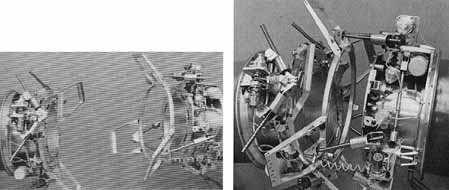
Preliminary Systems Review (Stage
I)
Under the direction of V. S. Syromyatnikov, the Soviet Group 3 team had readied their documentation in both English and Russian and had prepared their two-fifths-scale model of the docking system for the joint meeting. Some of the Americans observed that while the U.S.S.R. mechanism was more complex mechanically than the American one, it was suitable for the mission and "sophisticated" in its execution. The two sides reviewed and signed the two-fifths-model test plan and scheduled the test for December in Moscow. Another important Group 3 milestone was the completion of the first part of the docking system Preliminary Systems Review (PSR).35
The PSR was planned to be a "formal configuration review . . . initiated near the end of the conceptual phase, but prior to the start of detail design" work on the docking mechanism. As part of their presentation to the Preliminary Systems Review Board (the Board being the Technical Directors), Don Wade and Vladimir Syromyatnikov included all the test data, specifications, and drawings for the docking system, as well as a design evaluation for the mechanism. After hearing their report, Lunney and Bushuyev felt three problem areas needed further study. First, the requirement for a spring thruster designed to help separate the two spacecraft had caught their attention, since the failure of this thruster to compress properly could prevent completion of docking. Second, Lunney and Bushuyev emphasized the importance of an indicator that would verify that the structural latches were properly in place. The American system provided information on the functioning of each latch but did not indicate that the interface seals were compressed, while the Soviet system gave data on compression of the seals but none for the latches. To assure the structural integrity of the transfer tunnel, it was important to know that all eight latches were closed.36 The third problem area also dealt with those structural latches. Was it possible that they could be inadvertently released? Bushuyev and Lunney called for a thorough re-evaluation of all these issues and advised Group 3 to present their specific recommendations to them in December and January.37
Don Wade, the American chairman, was not completely happy with the...

....manner in which the PSR had been executed. In his opinion, toward the end of the review session, matters became "pretty fouled up." Nevertheless, the teams did achieve their goals at the PSR, and Wade believed that the second phase of the review scheduled for December would be accomplished in a more orderly fashion. But the development of international space hardware was not an easy task. The Americans and Soviets were still learning to work together, and while Lunney had commented that working with the Russian specialists was quite similar to working with a new contractor there was one significant difference. In the Apollo-Soyuz Test Project, the two teams were equal partners. Neither side could tell the other how to do its work. Instead, engineering agreements had to be negotiated, undoubtedly a new experience for both countries. Two men were particularly aware of this difference; Lunney and Bushuyev kept their teams in line as the process of learning to work together continued.38
35. Lunney, "Minutes, ASTP Staff Meeting, October 25, 1972," 30 Oct. 1972. Donald C. Wade expressed some unhappiness with the Soviet model in Wade to Lunney, memo, "Working Group #3 Debriefing Notes for the October 1972 Meeting in Moscow," 1 Nov. 1972.
36. "Apollo Soyuz Test Project, October 12 and 13, 1972, Preliminary Systems Review (Stage 1)" [13 Oct. 1972].
38. Wade to Lunney,
memo, "Working Group #3 Debriefing Notes for the October 1972 Meeting
in Moscow," 1 Nov. 1972.
Next